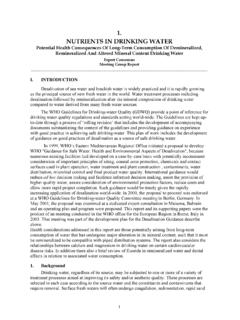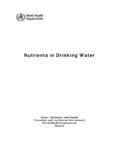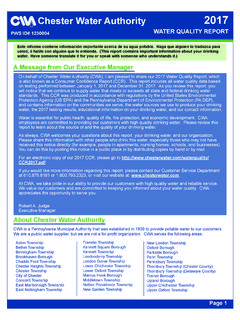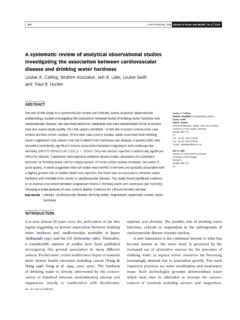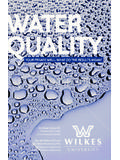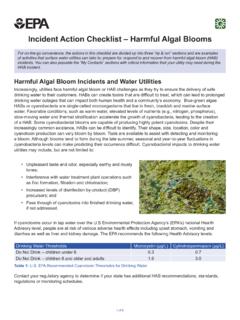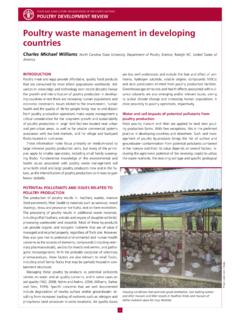Transcription of Cyanotoxin Management in Drinking Water - US EPA
1 Recommendations for Public Water Systems to Manage Cyanotoxins in Drinking Water June 2015 Office of Water (4606M) EPA 815-R-15-010 June 2015 Disclaimer This document was prepared by the Environmental Protection Agency (EPA) as an informational resource for public Water systems and primacy agencies to prepare for and respond to the risk of cyanotoxins in finished Water . This document is not a regulation; it is not legally enforceable; and it does not confer legal rights or impose legal obligations on any party, including EPA, States, or the regulated community. While EPA has made every effort to ensure the accuracy of the discussion in this document, the obligations of the regulated community are determined by statutes, regulations, or other legally binding requirements. The recommendations discussed are not a substitute for applicable legal requirements.
2 In the event of a conflict between the discussion in this document and any statute or regulation, this document would not be controlling. Although this document describes suggestions for managing Cyanotoxin issues in raw and finished Water , the recommendations may not be appropriate for all situations and alternative approaches may be applicable. Mention of trade names or commercial products does not constitute an EPA endorsement or recommendation for use. This Page Intentionally Left Blanki Table of Contents Table of Contents .. i Table of Exhibits .. ii Abbreviations and Acronyms .. iii Acknowledgements .. iv Preparers and Reviewers .. v Executive Summary .. vi A. Introduction B. What is a Health Advisory? C. Cyanotoxin Management Plan Development D. Potential Cyanotoxin Management Steps 1 Step 1: Conduct System-Specific Surface Water Evaluation 2 Step 2: Preparation and Observation Preparation Observation Visual Inspection and Phytoplankton Identification System Effects Other Bloom Indicators Communication Source Water Mitigation 3 Step 3: Monitor for Cyanotoxins in Raw Water and Treatment Adjustments Sampling and Analysis for Cyanotoxins Raw Water Sampling Sampling Logistics Analytical Methods Communications Treatment 4 Step 4: Monitor for Cyanotoxins in Raw and Finished Water and Treatment Adjustments Monitoring Communications Treatment 5 Step 5.
3 Monitor for Cyanotoxins in Finished Water , Treatment Adjustments or Additions, and Public Communications Monitoring Communications Treatment 28 Appendix A System-Specific Evaluation Information, Tools, and Resources 38 Appendix B Examples of Water Utility and Community Responses to Harmful Algal Blooms48 Appendix C Key Questions and Answers 50 Appendix D Potential Language for Use in a Cyanotoxin Public Notification and Social Media54 Appendix E Long Term Mitigation Strategies and Treatment Options56 ..6 References ..ii Table of Exhibits Figure 1. Potential Management steps public surface Water systems may use to determine whether cyanotoxins are present in raw Water or finished Drinking Water .. 5 Figure 2. Traffic light approach to support communication and other actions in response to elevated concentrations of cyanotoxins in finished Drinking Water .
4 27 iii Abbreviations and Acronyms ASDWA Association of State Drinking Water Administrators AWWA American Water Works Association CDC Centers for Disease Control and Prevention CMP Cyanotoxin Management Plan CT Concentration (oxidant) x Contact Time CWA Clean Water Act DAF Dissolved Air Flotation DBP Disinfection Byproduct DWACT Drinking Water Advisory Communication Toolbox DWMAPS Drinking Water Mapping Application for Protecting Source Waters ECHO Enforcement and Compliance History Online ELISA Enzyme Linked Immunosorbent Assay EPA Environmental Protection Agency GAC Granulated Activated Carbon HAAs Haloacetic Acids (HAA5) HAs Health Advisories HABs Harmful Algal Blooms LC/MS/MS Liquid Chromatography/Mass Spectrometry/Mass Spectrometry MCL Maximum Contaminant Level MF Microfiltration NF Nanofiltration MIB Methylisoborneol NOAA National Oceanic and Atmospheric Administration NPDAT Nitrogen and Phosphorus Data Access Tool NPDES National Pollution Discharge Elimination System NTU Nephelometric Turbidity Unit PAC Powdered Activated Carbon PWS Public Water System RO Reverse Osmosis SDWA Safe Drinking Water Act STORET STOrage and RETrieval SWC Source Water Collaborative TMDL Total Maximum Daily Load TTHMs Total Trihalomethanes UF Ultrafiltration USACE United States Army Corps of Engineers USDA United States Department of Agriculture EPA United States
5 Environmental Protection Agency USGS United States Geological Survey UV Ultraviolet WHO World Health Organization WRF Water Research Foundation iv Acknowledgements EPA s Office of Ground Water and Drinking Water would like to thank the Association of State Drinking Water Administrators, the States of California, Massachusetts, New York, Ohio, Oregon, Rhode Island and the Centers for Disease Control for their contributions to this document. Additionally, over 500 participants joined EPA at a May 11, 2015 public meeting discussing steps the Agency could take to support states and utilities in managing Cyanotoxin risks in Drinking Water . EPA thanks these participants for their meaningful input which was critical for the development of this document. v Preparers and Reviewers The following individuals helped to develop and review this document.
6 Hannah Holsinger ( EPA)1 Kenneth Rotert ( EPA)1 Lili Wang ( EPA)1 Rachel Carlson ( EPA)1 Ryan Albert ( EPA) Becky Allenbach ( EPA) Steve Allgeier ( EPA) Blake Atkins ( EPA) Michael Baker (Ohio EPA) Michael Beach (CDC) Phil Berger ( EPA) Kimberly Burnham (Ohio EPA) Andrea Candara (New York State Department of Health) Gregory Carroll ( EPA) Michael Celona (Massachusetts Department of Public Health) Jimmy Chen ( EPA) Robert Clement ( EPA) Lesley D Anglada ( EPA) Kristin Divris (Massachusetts Department of Environmental Protection) Katharine Dowell ( EPA) Allison Dugan ( EPA) Nicholas Dugan ( EPA) Michael Elovitz ( EPA) Mike Finn ( EPA) Stephanie Flaharty ( EPA) Dan Hautman ( EPA) Austin Heinrich (ORISE participant)2 Susan Holdsworth ( EPA) James Hyde (New York State Department of Health) Holly Kaloz (Ohio EPA) Kirk Leifheit (Ohio EPA) Darren Lytle ( EPA) Casey Lyon (Oregon Health Authority) Beth Messer (Ohio EPA) Mike Messner ( EPA) Jini Mohanty ( EPA) Thomas Poy ( EPA) Aditi Prabhu ( EPA) Heather Raymond (Ohio EPA) Stig Regli ( EPA) Crystal Rodgers-Jenkins ( EPA) Karen Sklenar Glynda Smith ( EPA) Thomas Speth ( EPA) June Swallow (Rhode Island Department of Health) Jim Taft (Association of State Drinking Water Administrators) Nicole Tucker ( EPA) Tom Waters ( EPA) Steve Wendelken ( EPA) Lloyd Wilson (New York State Department of Health) Jonathan Yoder (CDC) Lester Yuan ( EPA) George Zoto (Massachusetts Department of Environmental Protection)
7 1 Lead Preparer 2 Oak Ridge Institute for Science and Education (ORISE) participant vi Executive Summary This Cyanotoxin Management document is a companion to the United States Environmental Protection Agency s (EPA) Health Advisories (HAs) for microcystins and cylindrospermopsin. Human exposure to cyanotoxins can result in a host of adverse health effects, including gastroenteritis, liver damage and kidney damage. The HA values represent concentrations in Drinking Water below which adverse noncarcinogenic effects are not expected to result from the ingestion of Drinking Water . Derivation of the HAs is described in detail in the final EPA HA documents for these cyanotoxins. Cyanotoxins can enter Drinking Water supplies as a result of the growth of harmful algal blooms (HABs) in surface Water sources or ground Water sources under the direct influence of surface Water .
8 The formation of algal blooms is dependent upon a number of environmental conditions, including the presence of nutrients (such as nitrogen, phosphorus), climate, and stratification of the Water source. This document is intended to assist public Drinking Water systems (PWSs) that choose to develop system-specific plans for evaluating their source waters for vulnerability to contamination by microcystins and cylindrospermopsin. It could also serve as a model for addressing potential concerns from other cyanotoxins in the future. The document provides a stepwise approach PWSs could use to inform their decisions on whether and how to monitor and (or) treat for microcystins and cylindrospermopsin and when and how to communicate with stakeholders. The stepwise approach includes the following five steps: Step one involves conducting a system-specific evaluation for vulnerability to blooms; Step two suggests activities for preparing and observing for potential blooms; Step three describes monitoring activities to determine whether cyanotoxins are present in the raw Water , and recommended communication and treatment activities if cyanotoxins are found in the raw Water ; Step four describes monitoring activities to determine whether cyanotoxins are present in finished Water and recommended communication and treatment activities if cyanotoxins are found.
9 And Step five describes continued finished Water monitoring (confirming the initial finished Water sample in Step 4), treatment and communication activities if cyanotoxins are found in the finished Water above acceptable levels. This document provides information and a framework that PWSs may consider if they choose to develop a system-specific Cyanotoxin Management plan (CMP). This document includes a three-tiered, traffic light strategy as an example of an approach that could be used to provide information to the public about algal toxin levels in local Drinking Water . Clear and effective communication is critical to support informed choices about how to best protect the public from adverse health impacts from HABs. It can also support the states in assisting PWSs and other stakeholders in their Cyanotoxin risk Management efforts.
10 The recommendations in this document may be updated over time as EPA receives new relevant information related to vii effective strategies for monitoring, treatment and communication with stakeholders regarding Management of cyanotoxins in Drinking A. Introduction Cyanobacteria, also known as blue-green algae, naturally occur within marine and fresh Water ecosystems. Some cyanobacteria are capable of producing toxins, called cyanotoxins, which can pose a risk to human health ( EPA, 2014a). Under certain conditions cyanobacteria can grow rapidly, producing cyanobacterial blooms, often referred to as HABs. A bloom is a rapid and excessive growth of cyanobacteria (AWWA and WRF, 2015). It is not possible to determine solely upon visual observation if a bloom is producing toxins, thus any bloom is potentially dangerous.










